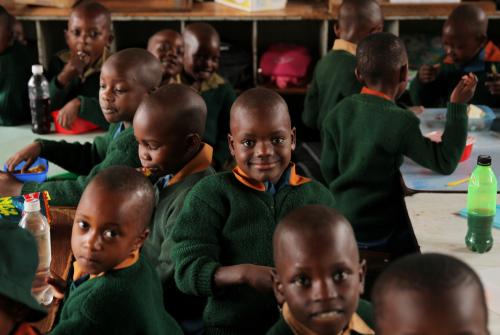Across the world, governments, civil society organizations, educators, and other innovators are testing new and different approaches to improve student learning. While many innovations show promise at a small scale, the unfortunate reality is that the majority do not have a lasting impact at large scale. Scaling the impact of an innovation requires more than a strong technical model tailored to a specific context. Scaling impact is also dependent upon factors that may be beyond the full control of the implementers, including alignment with broader education landscapes, the knowledge and capacity to respond to windows of opportunity, sufficient resources to support high-quality delivery, and the cultivation of a network of champions.
Millions Learning, a project of the Center for Universal Education (CUE) at the Brookings Institution, explores scaling and sustaining effective innovations leading to improved system-wide approaches. CUE is implementing a series of Real-time Scaling Labs (RTSLs), in partnership with local institutions in several countries, to generate evidence and provide practical recommendations around the process of scaling in global education. In 2019, CUE, in partnership with Youth Impact, launched an RTSL in Botswana focused on the process of implementing, adapting, scaling, and sustaining the Teaching at the Right Level (TaRL) approach in primary schools across the country. See Figure 1 for the impact of students participating in TaRL.
Figure 1. Learning outcomes for students participating in TaRL (2022)
 Source: Youth Impact, 2022.
Source: Youth Impact, 2022.
The case of TaRL in Botswana offers a rich example of how an innovation developed and refined in one context can be adapted to and strategically expanded in a new location by a local organization in partnership with the government. While TaRL’s scaling journey in Botswana is still unfolding, the case provides an opportunity to investigate key facilitating factors, decisions, and barriers that have contributed to and constrained the scaling process to date. Section one provides an overview of the RTSL, the education ecosystem in Botswana, and the history of TaRL internationally. Section two analyzes some critical factors, opportunities, and challenges related to the design, delivery, and financing of TaRL in Botswana. This section also identifies four key lessons that can inform the work of policymakers, program designers, and implementing organizations striving to scale and sustain TaRL in other contexts and the work of other innovations around the world aiming to improve learning outcomes for all children. Finally, section three considers next steps for the scaling journey of TaRL in Botswana.
Download the executive summary.
Cover photo courtesy of Hannah Blair
The Brookings Institution is committed to quality, independence, and impact.
We are supported by a diverse array of funders. In line with our values and policies, each Brookings publication represents the sole views of its author(s).













